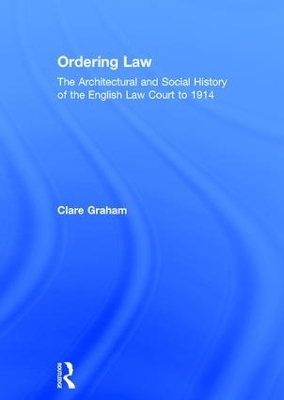
Ordering Law
The Architectural and Social History of the English Law Court to 1914
Seiten
2003
Routledge (Verlag)
978-0-7546-0787-8 (ISBN)
Routledge (Verlag)
978-0-7546-0787-8 (ISBN)
- Titel z.Zt. nicht lieferbar
- Versandkostenfrei
- Auch auf Rechnung
- Artikel merken
In this work, Clare Graham establishes when, how and why English trials came to be housed in purpose-built accommodation and what made such buildings architecturally distinctive. The author shows how these buildings grew out of legal procedure.
Over the last thirty years, historical studies of building types have become something of a growth area. As well as such general surveys as Nikolaus Pevsner's History of Building Types, there are growing numbers of studies of individual types, of which the most distinguished perhaps remain Mark Girouard's Life in the English Country House and Robin Evan's study of prisons, The Fabrication of Virtue. This growth is not surprising, because the subject lends itself to the 'New Art History', and to our increasing desire to set buildings within their social and cultural contexts, as well as their stylistic and cultural ones. This book by Dr Graham is a comprehensive study of a type of building - the law court - which has, to date, remained largely unexplored. Ordering Law establishes when, why and how the trial came to be housed in purpose-built accommodation in England, and what was architecturally distinctive about that accommodation in the period leading up to 1914. The main text concentrates on examining in depth a series of well-documented individual buildings and groups of buildings, using a wide range of contemporary sources to illuminate the way in which they were designed and used. Other information gleaned about court buildings nationwide is placed in an appendix, in gazetteer form; originally drawn from the 200 or so examples listed in the Buildings of England guides, this has expanded to include over 800 entries. As a piece of scholarly research, this work draws on several disciplines and will be of interest to those studying social and legal history, as well as those with a broader interest in architectural history.
Over the last thirty years, historical studies of building types have become something of a growth area. As well as such general surveys as Nikolaus Pevsner's History of Building Types, there are growing numbers of studies of individual types, of which the most distinguished perhaps remain Mark Girouard's Life in the English Country House and Robin Evan's study of prisons, The Fabrication of Virtue. This growth is not surprising, because the subject lends itself to the 'New Art History', and to our increasing desire to set buildings within their social and cultural contexts, as well as their stylistic and cultural ones. This book by Dr Graham is a comprehensive study of a type of building - the law court - which has, to date, remained largely unexplored. Ordering Law establishes when, why and how the trial came to be housed in purpose-built accommodation in England, and what was architecturally distinctive about that accommodation in the period leading up to 1914. The main text concentrates on examining in depth a series of well-documented individual buildings and groups of buildings, using a wide range of contemporary sources to illuminate the way in which they were designed and used. Other information gleaned about court buildings nationwide is placed in an appendix, in gazetteer form; originally drawn from the 200 or so examples listed in the Buildings of England guides, this has expanded to include over 800 entries. As a piece of scholarly research, this work draws on several disciplines and will be of interest to those studying social and legal history, as well as those with a broader interest in architectural history.
Clare Graham, The Rose Theatre Trust, UK
Contents: Introduction: In the beginning: rituals, traditions and the law; From castle to sessions house; Questions of type, function and timing; Pressure and change; Police courts; County courts; Coroners' courts; Symbolic courts; Conclusion; Appendices; Index.
| Erscheint lt. Verlag | 21.8.2003 |
|---|---|
| Verlagsort | London |
| Sprache | englisch |
| Maße | 174 x 246 mm |
| Gewicht | 1406 g |
| Themenwelt | Geisteswissenschaften ► Geschichte |
| Recht / Steuern ► Allgemeines / Lexika | |
| Recht / Steuern ► EU / Internationales Recht | |
| Technik ► Architektur | |
| ISBN-10 | 0-7546-0787-9 / 0754607879 |
| ISBN-13 | 978-0-7546-0787-8 / 9780754607878 |
| Zustand | Neuware |
| Haben Sie eine Frage zum Produkt? |
Mehr entdecken
aus dem Bereich
aus dem Bereich
eine kleine Soziologie des Heavy Metal
Buch | Softcover (2023)
Kohlhammer (Verlag)
CHF 29,90
Projekte, Visionen, Luftschlösser
Buch | Hardcover (2023)
Lehmstedt Verlag
CHF 41,95


